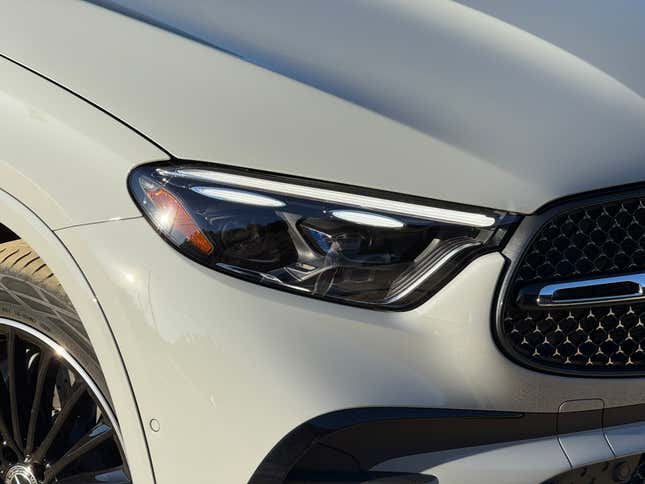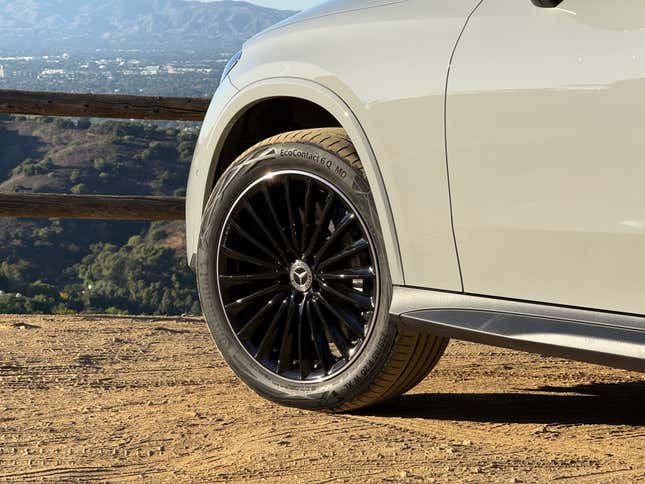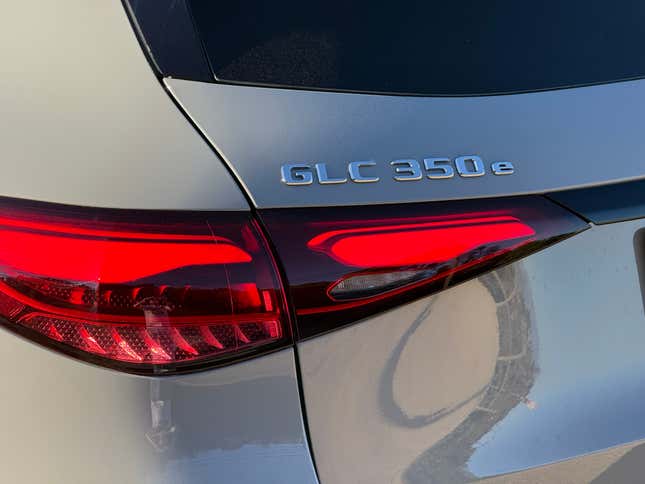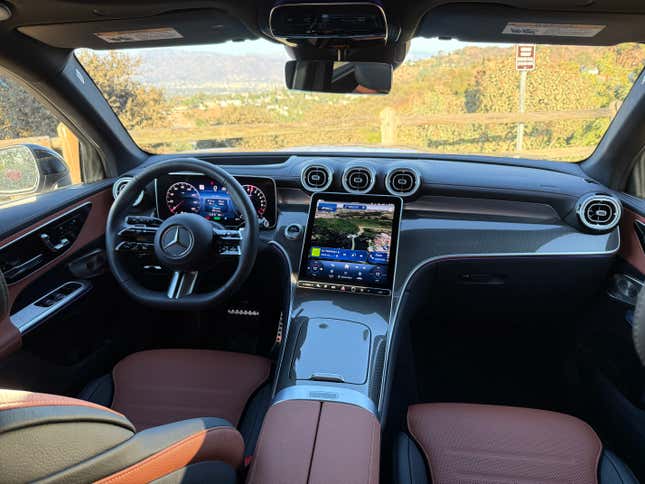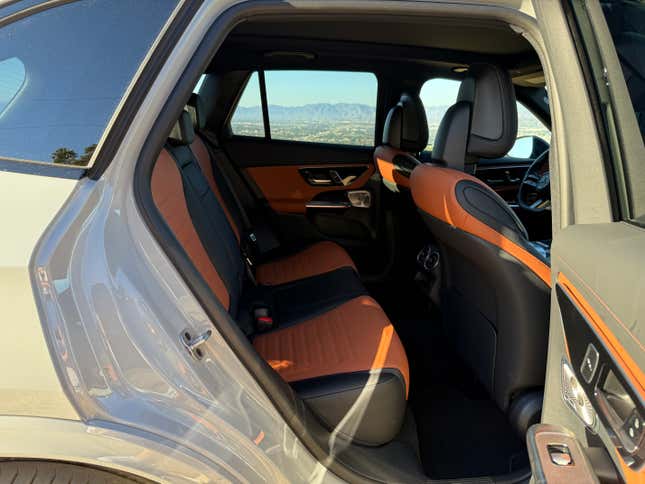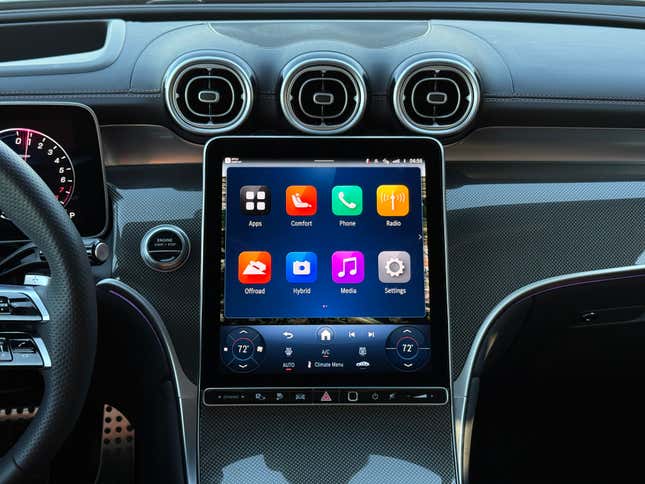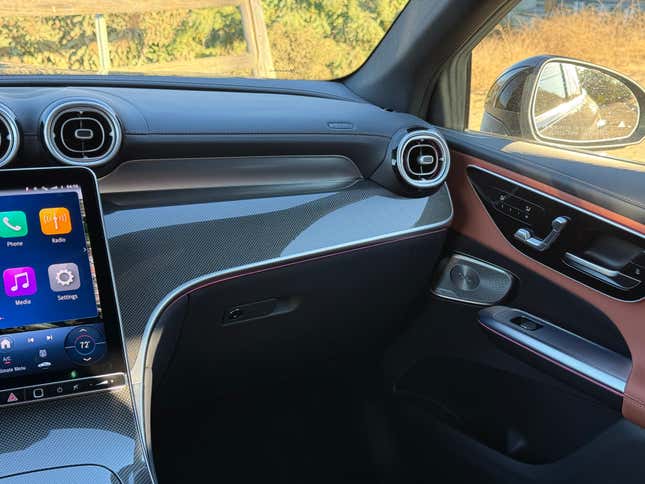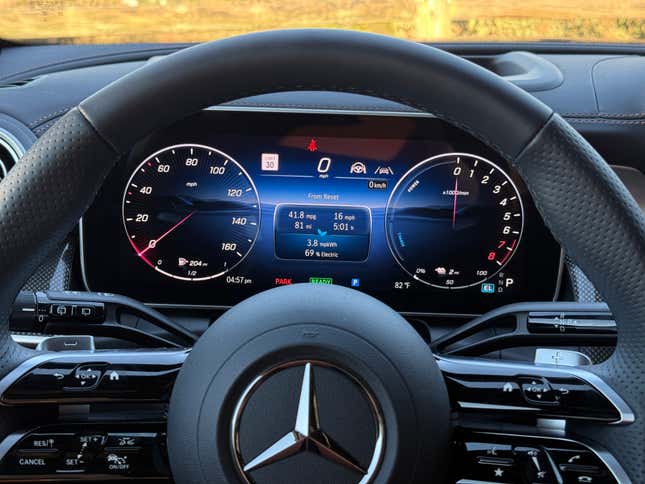It’s now been 15 years since the first plug-in hybrids started coming on the market, and we’re finally getting PHEVs with genuinely usable electric ranges of more than just a few miles. The PHEV with the longest EV range you can buy right now is a bit surprising, partially because it’s just so… normal. Taking the crown with an EPA-rated electric-only range of 54 miles is the 2025 Mercedes-Benz GLC350e, the plug-in version of Benz’s best-selling compact crossover.
Spending a week with the GLC350e revealed it to be a fantastic offering in the segment, and one of the best non-performance-oriented PHEVs on the market. There is one major problem, though: For almost the entire time I was in it, I wished I was driving a fully electric vehicle instead. That’s not to say the plug-in GLC won’t be a great solution for a lot of people, but unless you take full advantage of the powertrain, I think a pure EV would be nicer.
Full disclosure: Mercedes-Benz delivered the GLC350e to the airport with a full tank of gas so I could drive it around Los Angeles for a week after coming home from a trip.
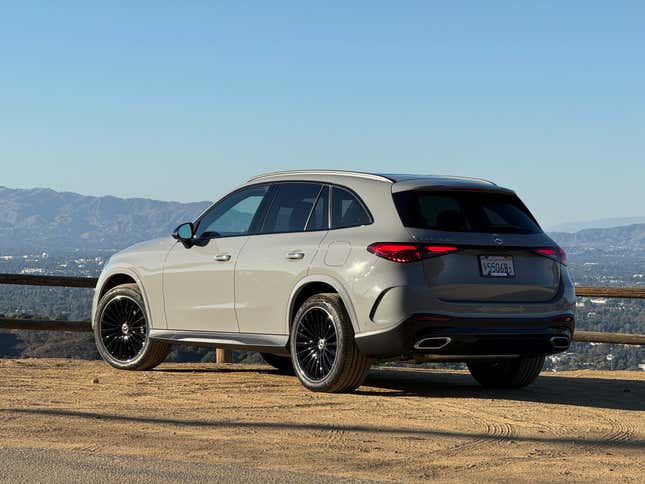
Forming the basis of the GLC350e’s powertrain is the same turbocharged 2.0-liter inline-4 used by lots of other cars in the Mercedes lineup. Here it makes 201 horsepower and 236 pound-feet of torque on its own, 54 hp and 59 lb-ft less than in the GLC300 where it’s paired with a 48-volt mild-hybrid system. The GLC350e adds on an electric motor that puts out 134 hp and 325 lb-ft for a total system output of 313 hp and 406 lb-ft, which is more torque than you get in the Mercedes-AMG GLC43. A battery pack underneath the cargo area has 23.3 kWh of usable capacity to provide juice to the system.
Mercedes says the GLC350e will hit 60 mph in 6.2 seconds, the same as the gas-only GLC300, but the instant torque punch of the electric motor makes the PHEV more enjoyable around town. The GLC defaults to Electric mode on start-up, and it’ll do up to 87 mph on electricity alone, though even in EV mode if you press the accelerator past a certain point the gas engine will kick in (there’s a nice gauge in the digital cluster that shows how close you are to hitting that point). In Hybrid mode the GLC prioritizes electric operation as much as possible — after traveling 66 miles I had used up all of the battery’s charge, with the car telling me that 85 percent of my driving had been with just electric power.

In Electric and Hybrid modes the GLC350e offers regenerative braking with two intensity levels that are controlled by the steering wheel paddles, the stronger of which won’t bring you to a complete stop but is still quite helpful in most situations thanks to a maximum recuperation force of up to 100 kW. Annoyingly, like on Mercedes’ fully electric EQ cars, the brake pedal physically moves under regenerative deceleration, though only by a little bit.
Fully deplete the battery and the GLC will still drive using just electricity whenever possible, usually in short bursts around town, and the engine often cuts out when coasting. You can charge up the battery by driving in Sport mode, in which the gas engine is always on, but it takes an extremely long time to even add a couple miles of range this way, and in Sport mode there’s no regenerative braking. The transition between EV power and the engine turning on is extremely smooth, nearly unnoticeable whether it’s kicking on at a stoplight or while cruising on the highway. Sadly, the engine itself is pretty coarse and loud even at low revs, not matching up with the sereneness of the GLC’s electric side.
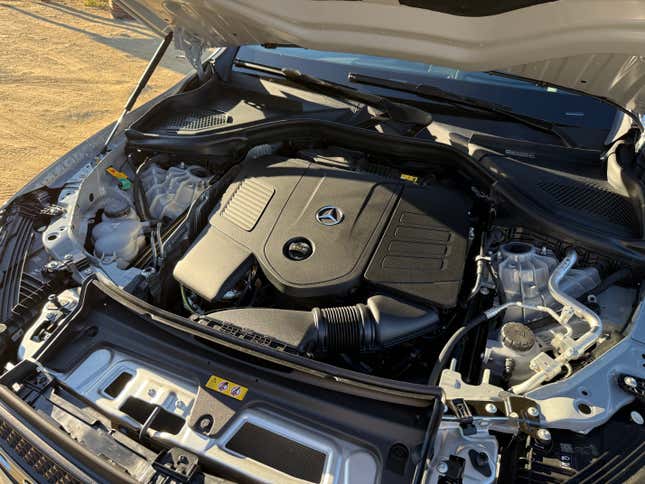
While the GLC350e’s electric range is impressive, its overall driving range is not. When I picked it up with a full tank of gas and a fully charged battery, the car’s display showed a total range of only 250 miles; after using up all of the battery that estimate remained the same, so my guess is real-world total range is somewhere around 300 miles. (The GLC350e isn’t on the EPA website yet, so no official total range is given, but the nonhybrid GLC300 boasts an EPA range of 452 miles.) When there are so many fully electric vehicles out there with ranges easily exceeding 300 miles, including within Mercedes’ own lineup, it would be an easy decision for me to go for an EV over this PHEV. Sure, for those that often have to go far beyond an EV’s range and who don’t want to have to charge while road-tripping, the GLC350e’s setup will be useful. The GLC highlights why EVs are so much better to daily drive — they’re quieter, smoother, quicker, calmer. When that turbo four kicks in, and when the battery is low on charge, you’re just in a normal gas-powered crossover saddled with additional weight that occasionally offers a glimmer of nice electric driving.
At least the GLC350e’s battery can be fast-charged, which is still a novelty for plug-in hybrids. Using a CCS plug the GLC can be juiced at up to 60 kW, good enough to fully recharge the battery in just 30 minutes. That’s way better than having to use a slow Level 2 charger to fill up a relatively small PHEV battery, typically one of my biggest annoyances with them. Of course, you can just use a Level 2 or wall outlet to charge, as the GLC comes with an AC adapter that can charge at up to 11 kW. The GLC350e’s electric range being so long means it’ll last at least a few days’ worth of regular driving for most people, and if it gets recharged every night you’ll rarely dip into the gas reserves. Again, though, if that’s the case and you aren’t regularly doing long journeys, I’d much rather have a pure EV.
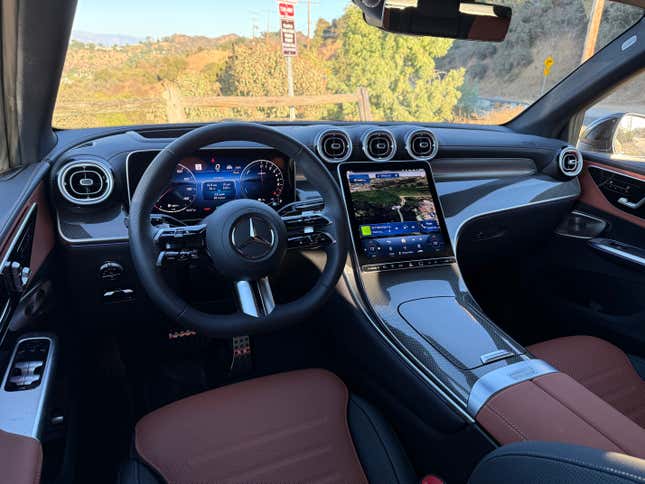
Powertrain aside, the GLC350e feels just like any other GLC, which is to say it’s an extremely nice crossover. This generation of GLC looks really damn good, particularly with the $3,450 AMG Line appearance package that adds different bumper designs, sportier wheels and a grille full of little Mercedes stars. The only indication that you’re looking at a plug-in hybrid is the charge port on the driver’s side rear fender; there aren’t even any EQ badges or differently colored brake calipers like on some other PHEV Benzes. While it’s a pretty played out shade at this point, I do think the Manufaktur Alpine Grey paint looks really nice on the GLC, especially later in the day when the grey absorbs a lot of warmth from the setting sun.
The GLC’s interior is even better, and my test car is a great spec. Its $1,620 Sienna Brown leather looks and feels nice and is well paired with the Metal Weave trim, and overall the interior is better screwed-together than other new Benzes I’ve been in, with nary a squeak or flimsy piece of trim. For 2025 the GLC gets Mercedes’ updated MBUX infotainment system that has simplified menus and graphics, and it remains one of my favorite systems on sale. It also has wireless Apple CarPlay and Android Auto, but I much prefer Mercedes’ native navigation and setup.
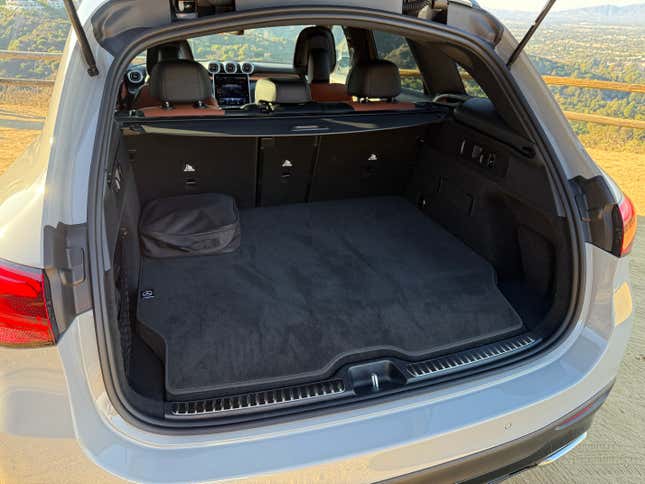
Another benefit of the GLC350e versus other GLCs is the addition of air suspension to the rear axle, which helps offset and deal with the weight added by putting the battery back there. It definitely rides better than the standard GLC, but it would be even nicer if Mercedes had added air springs to the front too, as the front end can feel overly crashy over bumps and rough pavement when the rear is smoother. Some of that roughness could be chalked up to the $1,150 20-inch wheels, though they were wearing Continental EcoContact 6Q tires with a good amount of sidewall. Mercedes used to offer four-corner air suspension on the previous-gen GLC, and you can still get it on the current one in Europe. I also wish the U.S.-spec GLC were available with rear-wheel steering like the European one is.
The GLC350e is on sale now with a starting price of $61,050 including destination, $8,650 more than an all-wheel-drive GLC300. That’s a no-brainer upgrade to me given how much extra flexibility you get with the PHEV, especially if you’re able to plug in at home or at work. It’s also right in line with its closest competitors, the Lexus NX PHEV ($62,415 with 37 miles of range) and the Volvo XC60 PHEV ($59,345 with 36 miles of range).

My test car was nearly loaded, with features like a $1,500 panoramic sunroof, $450 ventilated front seats, $1,950 driver assistance package and the $4,150 Pinnacle trim that adds excellent ambient lighting, navigation, a 3D Burmester surround sound system, LED lights with projected animations, a head-up display, heat and noise-insulated glass, a surround-view camera system that can detect and accident and take photos, and more. All in, this GLC350e was $77,020, about two grand less than the cheapest EQE SUV (admittedly a larger vehicle). That may be a lot for a four-cylinder compact crossover, but it feels worth the scratch.
Luckily, my desires are being answered. Mercedes is phasing out its EQ lineup, instead focusing on coming out with electric versions of existing models that share the same design language, and one of the first examples of that new philosophy will be the next-generation GLC that’s coming as soon as next year. It will simply be a GLC that happens to be electric, without riding on a compromised platform and with styling that’s not as off-putting. I think it’s important to have lots of choices out there to get more people into electrified vehicles, and PHEVs are a big part of accomplishing that, but for me, fully electric is already the answer.
